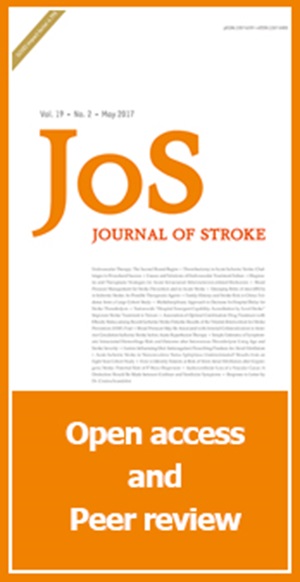Ethnic Differences in the Safety and Efficacy of Tenecteplase Versus Alteplase for Acute Ischemic Stroke: A Systematic Review and Meta-Analysis.
IF 8.6
1区 医学
Q1 CLINICAL NEUROLOGY
引用次数: 0
Abstract
Background and Purpose Tenecteplase is a thrombolytic agent with pharmacological advantages over alteplase and has been shown to be noninferior to alteplase for acute ischemic stroke in randomized trials. However, evidence pertaining to the safety and efficacy of tenecteplase in patients from different ethnic groups is lacking. The aim of this systematic review and metaanalysis was to investigate ethnicity-specific differences in the safety and efficacy of tenecteplase versus alteplase in patients with acute ischemic stroke. Methods Following an International Prospective Register of Systematic Reviews (PROSPERO)- registered protocol (CRD42023475038), three authors conducted a systematic review of the PubMed/MEDLINE, Embase, Cochrane Library, and CINAHL databases for articles comparing the use of tenecteplase with any thrombolytic agent in patients with acute ischemic stroke up to November 20, 2023. The certainty of evidence was assessed using the Grading of Recommendations Assessment, Development and Evaluation (GRADE) framework. Two independent authors extracted data onto a standardized data collection sheet. A pairwise meta-analysis was conducted in risk ratios (RR). Results From 34 studies (59,601 participants), the rate of complete recanalization was significantly higher (P<0.01) in Asian (RR: 1.91, 95% confidence interval [CI]: 1.30 to 2.80) versus Caucasian patients (RR: 0.99, 95% CI: 0.87 to 1.14). However, Asian patients (RR: 1.18, 95% CI: 0.87 to 1.62) had significantly higher (P=0.01) rates of mortality compared with Caucasian patients (RR: 1.10, 95% CI: 1.00 to 1.22). Caucasian patients were also more likely to attain a modified Rankin Scale (mRS) score of 0 to 2 at follow-up (RR: 1.14, 95% CI, 1.10 to 1.19) compared with Asian (RR: 1.00, 95% CI, 0.95 to 1.05) patients. There was no significant difference in the rate of symptomatic intracranial hemorrhage (P=0.20) and any intracranial hemorrhage (P=0.83) between Asian and Caucasian patients. Conclusion Tenecteplase was associated with significantly higher rates of complete recanalization in Asian patients compared with Caucasian patients. However, tenecteplase was associated with higher rates of mortality and lower rates of mRS 0 to 2 in Asian patients compared with Caucasian patients. It may be beneficial to study the variations in response to tenecteplase among patients of different ethnic groups in large prospective cohort studies.特奈普酶与阿替普酶治疗急性缺血性卒中的安全性和有效性的种族差异:系统回顾与元分析》。
背景和目的替奈普酶是一种溶栓药物,与阿替普酶相比具有药理优势,在随机试验中显示其治疗急性缺血性卒中的效果不劣于阿替普酶。然而,有关替奈普酶在不同种族患者中的安全性和有效性的证据还很缺乏。本系统综述和荟萃分析旨在研究替奈普酶与阿替普酶在急性缺血性卒中患者中安全性和有效性的种族特异性差异。方法根据国际系统性综述前瞻性注册(PROSPERO)注册协议(CRD42023475038),三位作者对PubMed/MEDLINE、Embase、Cochrane Library和CINAHL数据库中截至2023年11月20日的文章进行了系统性综述,比较了在急性缺血性卒中患者中使用替奈普酶和任何溶栓药物的情况。采用建议评估、发展和评价分级(GRADE)框架对证据的确定性进行评估。两位独立作者在标准化数据收集表上提取数据。结果34项研究(59601名参与者)中,亚裔患者(RR:1.91,95%置信区间[CI]:1.30至2.80)的完全再通率显著高于白种人患者(RR:0.99,95%置信区间:0.87至1.14)(P<0.01)。然而,亚裔患者的死亡率(RR:1.18,95% CI:0.87 至 1.62)明显高于白种人患者(RR:1.10,95% CI:1.00 至 1.22)(P=0.01)。与亚裔患者(RR:1.00,95% CI:0.95 至 1.05)相比,白种人患者在随访时更有可能达到改良兰肯量表(mRS)0 至 2 分(RR:1.14,95% CI:1.10 至 1.19)。亚裔和白种人患者的症状性颅内出血率(P=0.20)和任何颅内出血率(P=0.83)无明显差异。然而,与白种人患者相比,替尼替普酶与亚裔患者较高的死亡率和较低的 mRS 0 至 2 相关。在大型前瞻性队列研究中研究不同种族患者对替奈普酶反应的差异可能会有所裨益。
本文章由计算机程序翻译,如有差异,请以英文原文为准。
求助全文
约1分钟内获得全文
求助全文
来源期刊

Journal of Stroke
CLINICAL NEUROLOGYPERIPHERAL VASCULAR DISE-PERIPHERAL VASCULAR DISEASE
CiteScore
11.00
自引率
3.70%
发文量
52
审稿时长
12 weeks
期刊介绍:
The Journal of Stroke (JoS) is a peer-reviewed publication that focuses on clinical and basic investigation of cerebral circulation and associated diseases in stroke-related fields. Its aim is to enhance patient management, education, clinical or experimental research, and professionalism. The journal covers various areas of stroke research, including pathophysiology, risk factors, symptomatology, imaging, treatment, and rehabilitation. Basic science research is included when it provides clinically relevant information. The JoS is particularly interested in studies that highlight characteristics of stroke in the Asian population, as they are underrepresented in the literature.
The JoS had an impact factor of 8.2 in 2022 and aims to provide high-quality research papers to readers while maintaining a strong reputation. It is published three times a year, on the last day of January, May, and September. The online version of the journal is considered the main version as it includes all available content. Supplementary issues are occasionally published.
The journal is indexed in various databases, including SCI(E), Pubmed, PubMed Central, Scopus, KoreaMed, Komci, Synapse, Science Central, Google Scholar, and DOI/Crossref. It is also the official journal of the Korean Stroke Society since 1999, with the abbreviated title J Stroke.
 求助内容:
求助内容: 应助结果提醒方式:
应助结果提醒方式:


